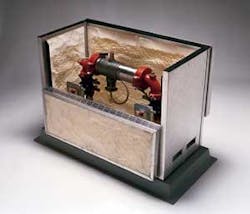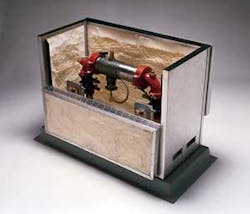Enclosures Enhance Security of Above-Ground Installations
By Alan Bullen
The security of our drinking water has always been of paramount concern. From the aquifers, rivers and reservoirs that we draw our water from to the treatment facilities to the distribution network, safeguards have always been in place to protect our water from toxins that might poison the drinking water we take for granted.
Prior to September 11, 2001, most concerns about the purity of our water centered around inadvertent, accidental contamination. Although the events of September 11 did not direct themselves against potable water, evidence has been found that al Quieda has acquired information pertaining to water distribution systems and may have plans to attack them. To address this threat, the EPA directed the majority of water districts in the country to perform threat vulnerability assessments and then to provide plans that would remedy the threat points.
Approximately two years ago, the American Water Works Association held a security seminar in Los Angeles. It was recognized at the seminar that there are many good reasons that pumping stations, valves, meters, etc. are positioned above ground, but also questioned the security of these placements if left without protection in the new climate of terrorism.
The enclosure industry has offered security to above ground placement of devices for practically 20 years. Since 1996, several manufacturers have had their "security-worthiness" certified as one of the standards agreed to in the American Society of Sanitary Engineers (ASSE) Standard 1060. Section 4.2 of the standard (referring to "Security and Vandalism") states "The method of providing access to the backflow preventer shall be lockable." It is the responsibility of the owner of the device and the enclosure to provide locking mechanism.
Certainly, this brief and simple statement seems almost innocent in regard to terrorism and indeed, its intent was directed almost singularly at vandalism. The water industry, however, has long seen the enclosure as a line of defense for the backflow preventer and other aspects of the downstream delivery system. At the previously mentioned AWWA security seminar, one of the presenters of the various security measures to be considered included aluminum and fiberglass enclosures in his presentation.
The enclosure as a security accessory to the water distribution industry covers a broad range of concepts and products. Enclosures range from wire cages that simply house the object inside to totally covered and "hiding" enclosures that keep a potential violator from knowing what is housed within. These "hiding enclosures" may be camouflaged to look like rocks and even tree stumps.
To some extent, size and purpose dictate the type of enclosure appropriate for the application. Either fiberglass or aluminum generally serves larger enclosure needs. Fiberglass enclosures generally are either one-piece lift-off or two piece hinged top access models. At least one manufacturer offers a four walled, two-door "house-type" enclosure with a roof that can be raised for additional access.
Aluminum units generally serve the largest enclosure needs. The methods of manufacturing vary depending on the companies involved but the one criteria a user of enclosures should look for is that the manufacturer be certified as an ASSE 1060 manufacturer. By doing this, the customer is assured that he is getting a tested enclosure that meets a variety of criteria, including security.
In addition to the lockable access criteria required by ASSE Standard 1060, all certified manufacturers instruct the purchaser of enclosures to bolt the product down rather than simply laying it over the device. Obviously, this renders unauthorized access more difficult. The ASSE Standard 1060 is currently being reviewed and updated and may well further address issues of device security.
Methods of manufacturing enclosures vary. One of the first manufacturers in the industry developed a method of construction of aluminum enclosures using a modular technique that allows for easy on-site assembly. Sections are shipped to the job site, positioned over the valve and secured in-place by toggle bolting the tongue-in-groove sections together and bolting the enclosure to a concrete pad.
Other manufactures have opted to manufacture "kit" form enclosures that include separate panels that are positioned together on the pad during installation. One manufacturer also now offers a new aluminum model that ships folded to the job site and then unfolds around the object it is to protect, in position, with only a drop down front to attach.
The enclosure industry is certainly not rocket science but there remains innovation. As a result of the terrorist threat, dial-out intrusion alarms can be installed in the enclosure to notify authorities if a site is breached, and other protections are being studied.
Security is not free. Enclosures are an investment. If you invest in an ASSE 1060 certified manufacturer's enclosure, you have the assurance of getting the most from your security system.
About the Author: Alan Bullen is National Sales Manager for Hot Box®.

